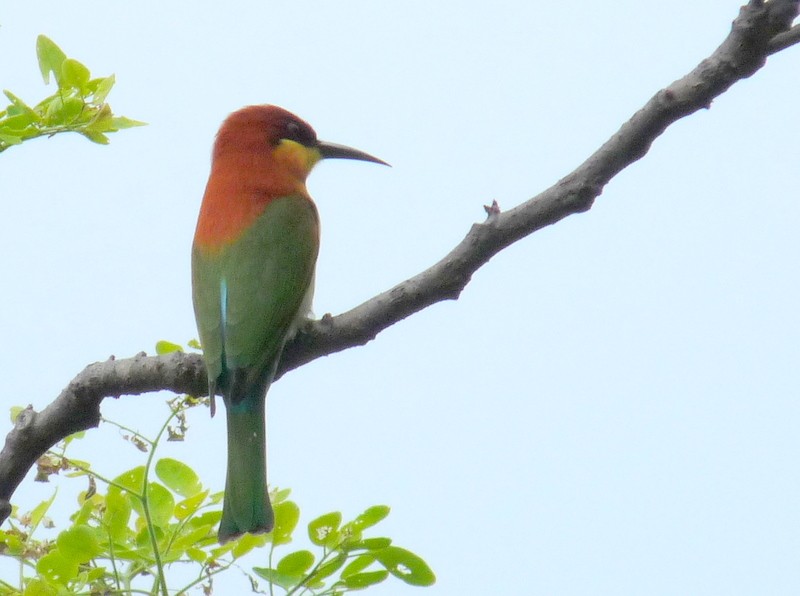Chestnut-headed Bee-eater
A species of Typical Bee-eaters Scientific name : Merops leschenaulti Genus : Typical Bee-eaters
Chestnut-headed Bee-eater, A species of Typical Bee-eaters
Botanical name: Merops leschenaulti
Genus: Typical Bee-eaters
Content
Description General Info
 Photo By K.Mohan Raj , used under CC-BY-SA-3.0 /Cropped and compressed from original
Photo By K.Mohan Raj , used under CC-BY-SA-3.0 /Cropped and compressed from original Description
Forehead, crown, nape, lower face and ear-coverts bright chestnut ; lores black, continued as a band under the eye and ear-coverts ; wing-coverts, lower back and tertiaries green, the latter tipped with bluish; rump and upper tail-coverts pale shining blue; primaries and secondaries green, rufous on the inner webs, and all tipped dusky ; central tail-feathers bluish on the outer, and green on the inner webs ; the others green, margined on the inner web with brown and all tipped dusky ; sides of face, chin and throat yellow ; below this a broad band of chestnut extending to the sides of the neck and meeting the chestnut of the upper plumage ; below this again a short distinct band of black and then an ill-defined band of yellow ; remainder of lower plumage green, tipped with blue, especially on the vent and under tail-coverts. The Javan sub-species, M. l. quinticolor, differs in having the whole space from the bill down to the black pectoral band pure yellow without any chestnut, and in having the tail blue. Race andamanensis found in the Andamans is slightly larger than the Indian race. Iris crimson ; bill black ; legs dusky black ; claws dark horn-colour. 
Size
20 cm
Colors
Brown
Black
Green
Yellow
Blue
Orange
Nest Placement
Burrow
Feeding Habits
Chestnut-headed Bee-eater's diet mainly consists of insects like bees, wasps, and hornets, snatched mid-flight from perches. Utilizing specialized hunting techniques, chestnut-headed Bee-eater captures prey in the air, showcasing unique dietary adaptations for consuming winged insects.
Habitat
Chestnut-headed Bee-eater typically inhabits sub-tropical open woodlands, often in highland regions and near water. The species prefers clearings, open forested areas, well-wooded countryside, plantations, and large gardens. It is also found in beach scrub, coastal dunes, and alongside riversides, roads, railways, and paths. Its elevation range is generally from sea-level up to 800 meters, but can locally extend to 1500 meters in some regions and up to 1600 meters in Nepal.
Dite type
Insectivorous
General Info
Feeding Habits
Bird food type
Species Status
Not globally threatened.
Scientific Classification
Phylum
Chordates Class
Birds Family
Bee-eaters Genus
Typical Bee-eaters Species
Chestnut-headed Bee-eater